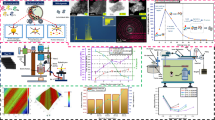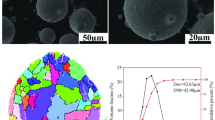Abstract
Three reaction systems of MoS2–Fe, FeS–Fe, and FeS–Fe–Mo were designed to investigate the use of FeS as an alternative to MoS2 for producing Fe-based friction materials. Samples were prepared by powder metallurgy, and their phase compositions, microstructures, mechanical properties, and friction performance were characterized. The results showed that MoS2 reacts with the matrix to produce iron-sulfides and Mo when sintered at 1050°C. Iron-sulfides produced in the MoS2–Fe system were distributed uniformly and continuously in the matrix, leading to optimal mechanical properties and the lowest coefficient of friction among the systems studied. The lubricity observed was hypothesized to originate from the iron-sulfides produced. The FeS–Fe–Mo system showed a phase composition, porosity, and density similar to those of the MoS2–Fe system, but an uneven distribution of iron-sulfides and Mo in this system resulted in less-optimal mechanical properties. Finally, the FeS–Fe system showed the poorest mechanical properties among the systems studied because of the lack of Mo reinforcement. In friction tests, the formation of a sulfide layer contributed to a decrease in coefficient of friction (COF) in all of the samples.
Similar content being viewed by others
References
R.M. German, Powder Metallurgy and Particulate Materials Processing: the Processes, Materials, Products, Properties, and Applications, Metal Powder Industries Federation, Princeton, 2005.
G.M. Zhang, K.Q. Feng, Y. Li, and H.F. Yue, Effects of sintering process on preparing iron-based friction material directly from vanadium-bearing titanomagnetite concentrates, Mater. Des., 86(2015), p. 616.
T. Ram Prabhu, V.K. Varma, and S. Vedantam, Effect of reinforcement type, size, and volume fraction on the tribological behavior of Fe matrix composites at high sliding speed conditions, Wear, 309(2014), No. 1-2, p. 247.
Z. Li, P. Xiao, and X. Xiong, Preparation and properties of C/C–SiC brake composites fabricated by warm compacted-in situ reaction, Int. J. Miner. Metall. Mater., 17(2010), No. 4, p. 500.
A. Savan, E. Pflüger, and P. Voumard, Modern solid lubrication: recent developments and applications of MoS2, Lubr. Sci., 12(2000), No. 2, p. 185.
A. Erdemir, Review of engineered tribological interfaces for improved boundary lubrication, Tribol. Int., 38(2005), No. 3, p. 249.
F.J. Clauss, Solid Lubricants and Self-lubricating Solids, Elsevier, Amsterdam, 2012.
B. Sustarsic, L. Kosec, S. Dolinsek, and B. Podgornik, The characteristics of vacuum sintered M3/2 type HSSs with MoS2 addition, J. Mater. Process. Technol., 143-144(2003), p. 98.
S. Dhanasekaran and R. Gnanamoorthy, Dry sliding friction and wear characteristics of Fe–C–Cu alloy containing molybdenum di sulphide, Mater. Des., 28(2007), No. 4, p. 1135.
S. Dhanasekaran and R. Gnanamoorthy, Heat generation in Fe–C–Cu–MoS2-sintered spur gears under unlubricated conditions, Proc. Inst. Mech. Eng. Part J, 221(2007), p. 645.
S. Dhanasekaran and R. Gnanamoorthy, Microstructure, strength and tribological behavior of Fe–C–Cu–Ni sintered steels prepared with MoS2 addition, J. Mater. Sci., 42(2007), No. 12, p. 4659.
S. Raadnui, S. Mahathanabodee, and R. Tongsri, Tribological behaviour of sintered 316L stainless steel impregnated with MoS2 plain bearing, Wear, 265(2008), No. 3-4, p. 546.
J. Han, J. Jia, J. Lu, and J. Wang, High temperature tribological characteristics of Fe–Mo-based self-lubricating composites, Tribol. Lett., 34(2009), No. 3, p. 193.
K.P. Furlan, C. Binder, A.N. Klein, and J.D.B. de Mello, Thermal stability of the MoS2 phase in injection moulded 17-4 PH stainless steel, J. Mater. Res. Technol., 1(2012), No. 3, p. 134.
K.P. Furlan, J.Z. de Assunção, G. Paz, C. Binder, and A.N. Klein, Sintering studies and microstructural evolution of Fe–MoS2 mixtures, Mater. Sci. Forum, 802(2014), p. 415.
K.P. Furlan, P.B. Prates, T. Andrea dos Santos, M.V. Gouvêa Dias, H.T. Ferreira, J.B. Rodrigues Neto, and A.N. Klein, Influence of alloying elements on the sintering thermodynamics, microstructure and properties of Fe–MoS2 composites, J. Alloys Compd., 652(2015), p. 450.
H. Wang, B. Xu, J. Liu, and D. Zhuang, Characterization and tribological properties of plasma sprayed FeS solid lubrication coatings, Mater. Charact., 55(2005), No. 1, p. 43.
H. Wang, B. Xu, J. Liu, and D. Zhuang, Investigation on friction and wear behaviors of FeS films on L6 steel surface, Appl. Surf. Sci., 252(2005), No. 4, p. 1084.
I. Lee and I. Park, Solid lubrication coating of FeS layer on the surface of SKD 61 steel produced by plasma sulfnitriding, Surf. Coat. Technol., 200(2006), No. 11, p. 3540.
R.M. German and K.A.D. Angelo, Enhanced sintering treatments for ferrous powders, Int. Mater. Rev., 29(1984), No. 1, p. 249.
Y. Wang, Q.Z. Yan, F.F. Zhang, C.C. Ge, X.L. Zhang, and H.Q. Zhao, Sintering behavior of Cr in different atmospheres and its effect on the microstructure and properties of copper-based composite materials, Int. J. Miner. Metall. Mater., 20(2013), No. 12, p. 1208.
B. Šuštaršič, L. Kosec, M. Jenko, and V. Leskovšek, Vacuum sintering of water-atomised HSS powders with MoS2 additions, Vacuum, 61(2001), No. 2-4, p. 471.
B. Bhushan, Introduction to Tribology, Wiley, 2013, p. 118.
Acknowledgements
Financial supports from the National Natural Science Foundation of China (No. 51572026) and the State Key Laboratory of Traction Power, Southwest Jiaotong University, China (No. TPL1612) are gratefully acknowledged.
Author information
Authors and Affiliations
Corresponding author
Rights and permissions
About this article
Cite this article
Peng, T., Yan, Qz., Zhang, Y. et al. Low-cost solid FeS lubricant as a possible alternative to MoS2 for producing Fe-based friction materials. Int J Miner Metall Mater 24, 115–121 (2017). https://doi.org/10.1007/s12613-017-1385-6
Received:
Revised:
Accepted:
Published:
Issue Date:
DOI: https://doi.org/10.1007/s12613-017-1385-6




